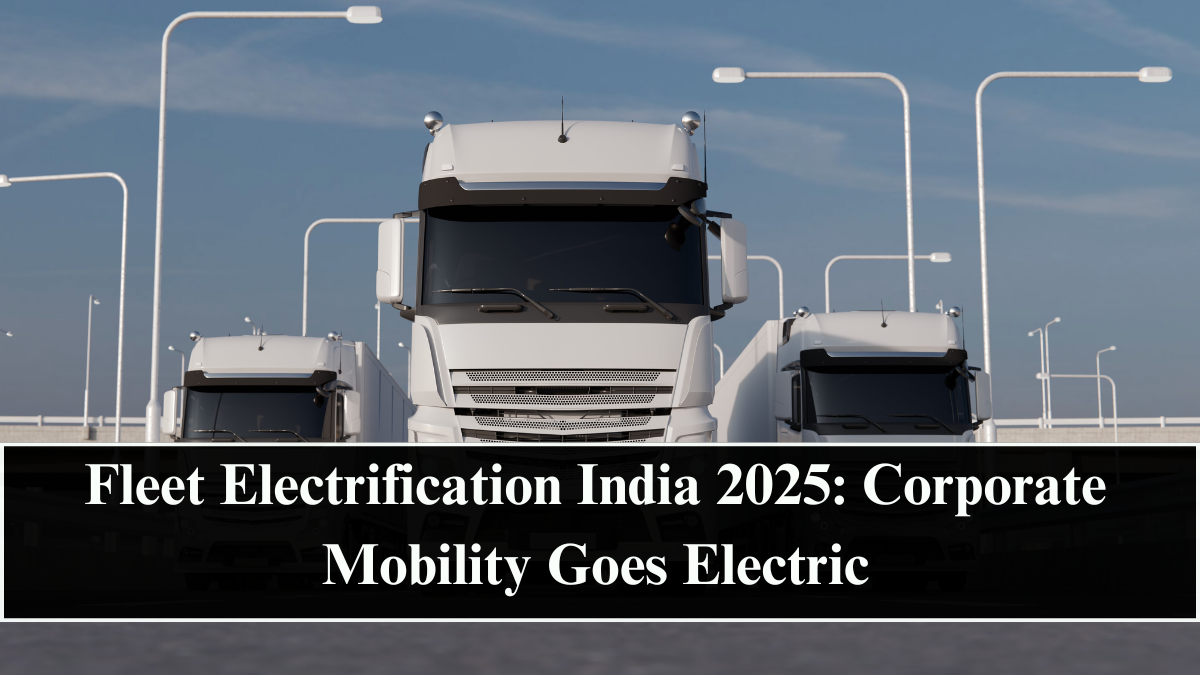The corporate mobility landscape in India is undergoing a major transformation. With Fleet Electrification India 2025, businesses are rapidly adopting electric vehicles (EVs) to achieve sustainability goals, lower operational costs, and comply with evolving green mobility regulations.
From logistics to employee transport, companies are replacing their internal combustion engine (ICE) fleets with electric cars, vans, and two-wheelers, reshaping India’s commercial mobility ecosystem.

Why Fleet Electrification Matters
Corporate fleets are among the largest contributors to vehicular emissions in India. As sustainability becomes a boardroom priority, electrifying fleets is now a strategic move, not just a green initiative.
EVs offer clear advantages:
-
Reduced operational costs: Electric vehicles cost 30–40% less to operate than diesel fleets.
-
Lower carbon footprint: Every EV in a corporate fleet helps cut CO₂ emissions by up to 4.6 tonnes annually.
-
Regulatory benefits: Incentives under FAME-II and state EV policies promote business fleet conversions.
-
Brand reputation: Sustainable fleets enhance ESG (Environmental, Social, Governance) credentials.
This shift is also supported by India’s target of 30% EV penetration by 2030, making 2025 a key inflection point for corporate adoption.
Leading Sectors Driving Fleet Electrification
The move toward electrification spans multiple industries, but key sectors leading the charge include:
-
E-commerce and Logistics: Companies like Amazon, Flipkart, and BigBasket are electrifying last-mile delivery operations.
-
Corporate Mobility and Ride-Hailing: Services such as BluSmart, Lithium Urban, and Ola Electric are setting new benchmarks in sustainable transport.
-
Public Sector and Government: Various agencies are transitioning official vehicles to EVs to comply with National Electric Mobility Mission (NEMMP) guidelines.
By 2025, it is estimated that over 1 million commercial EVs will operate across Indian cities — powering a low-emission logistics revolution.
Technology and Data Driving Fleet Transformation
The success of Fleet Electrification India 2025 is rooted in data analytics, IoT, and telematics. Companies are using smart fleet management systems to track real-time energy usage, vehicle health, and route efficiency.
Modern EVs come equipped with:
-
AI-based route optimization to maximize range.
-
Battery health monitoring using predictive analytics.
-
Telematics platforms that track energy, charging patterns, and driver performance.
These insights help businesses reduce downtime, extend battery life, and improve total cost of ownership (TCO).
Infrastructure and Policy Support
Government incentives are playing a crucial role in accelerating fleet electrification. Under the FAME-II scheme, commercial buyers receive subsidies for electric cars, two-wheelers, and cargo vehicles.
Cities like Delhi, Bengaluru, Hyderabad, and Pune are introducing dedicated EV zones, battery-swapping infrastructure, and corporate fleet tax rebates. The PLI scheme for Advanced Chemistry Cells (ACC) is also driving local production of high-capacity EV batteries.
Meanwhile, private players like Tata Power and ChargeZone are expanding fast-charging networks across highways and industrial hubs, ensuring fleets have reliable access to energy.
Sustainability and ROI Benefits
Fleet electrification not only benefits the planet but also makes strong financial sense. Over a 5-year period, electric fleets can reduce fuel and maintenance costs by up to 60%.
For large organizations, this translates into millions in annual savings. When paired with renewable energy sourcing — such as solar-based depot charging — fleet operations can become 100% carbon neutral.
Additionally, fleet data analytics enable precise carbon accounting and integration into corporate sustainability reporting frameworks, strengthening ESG compliance.
The Road Ahead for Corporate Mobility
By 2025, Fleet Electrification India is shaping a new corporate mobility paradigm. The convergence of technology, data, and sustainability goals is creating an ecosystem where electric fleets become the norm rather than the exception.
Looking forward, expect the rise of mobility-as-a-service (MaaS) platforms, autonomous electric logistics, and dynamic battery-swapping depots that enable 24/7 uptime for business fleets.
Fleet electrification isn’t just about going electric — it’s about driving India’s corporate sector toward a cleaner, smarter, and more efficient future.
FAQs
What is fleet electrification?
It’s the process of replacing internal combustion engine vehicles with electric vehicles for corporate, commercial, or logistics operations.
Why are Indian companies adopting electric fleets?
To cut costs, meet sustainability targets, and comply with government incentives under FAME-II and EV-friendly state policies.
Which industries are leading in fleet electrification?
E-commerce, logistics, and corporate mobility services are at the forefront, driven by companies like Amazon, Flipkart, and BluSmart.
What role does data play in EV fleet management?
Telematics and AI-based analytics help optimize routes, monitor energy use, and reduce maintenance downtime for EVs.
What is the future of fleet electrification in India?
By 2030, most corporate fleets will be fully electric, supported by AI-driven management systems and renewable energy infrastructure.
Click here to know more.
